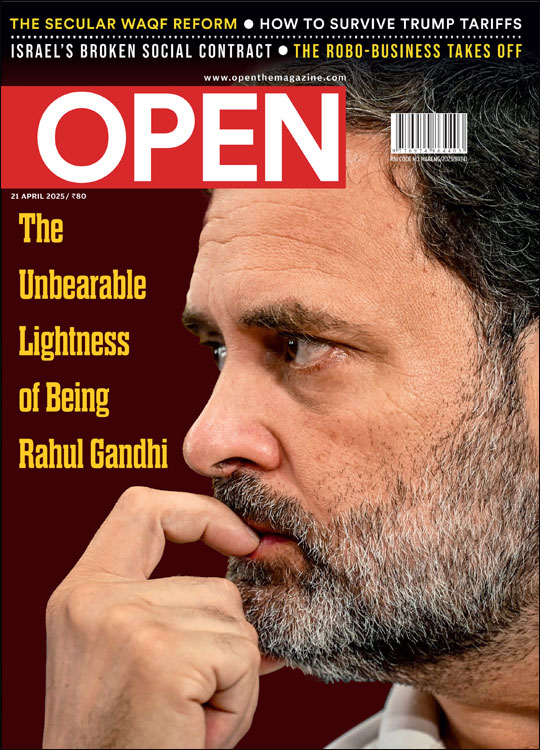LUTYENS SYNDROME
It’s one of the best addresses in Delhi—and one of the poshest and the classiest as well in its imperial elegance. Some occupants find it too good to vacate. We find out why
 Chinki Sinha
Chinki Sinha
 Chinki Sinha
|
30 Oct, 2014
Chinki Sinha
|
30 Oct, 2014
/wp-content/uploads/2015/11/Lutyenssyndrome1.jpg)
It’s one of the best addresses in Delhi—and one of the poshest and the classiest as well in its imperial elegance. Some occupants find it too good to vacate. We find out why
This isn’t a city. This is fantasia. Deep verandahs, and Corinthian columns, and sprawling lawns and courtyards. Sometimes, they say, peacocks venture near the glass windows, and in the night, they can be heard. Such exquisite sounds in the city of gardens— the Lutyens Bungalow Zone (LBZ). The cacophony of the rest of the metropolis with its millions of cars honking, and its vendors shouting, and the city itself clamouring for space, the din of construction and other city sounds… none of it drowns the sound of the cicadas chirping, and the leaves blowing in the evening breeze here. There’s also the luxury of silence, an indulgence, one that has been lost to cities in modern times. It is a place of power. It isn’t painful here. No ugliness touches it. It is a nostalgist’s shrine. It is abnormal, and as Member of Parliament Ram Jethmalani once put it “an offensively luxurious anomaly”.
It is like royalty, says someone who lived here once in a guest house. He speaks of how he would invite his friends over, and be amused by the look on their faces when they encountered the space that seemed to stretch beyond the stereotype of a city. These weren’t high-rises. Here, the buildings didn’t rise beyond the tall trees that grew around them. They hid behind a green veil.
In the heart of the city, the temperatures register a drop in the months of summer. Suddenly the air feels better, lighter, and in a metropolis that is finding its way into other states, clawing outwards at a speed that makes urban planners worry about a million things, life here is luxury. In the labyrinth of this neighbourhood that was built by the British to overshadow Mughal splendour, where all streets present an optical illusion of sorts with high walls and bungalows, it is like being in a bubble of everything that is power, or was, or could be.
But the Lutyens Syndrome (if it could be called that) is something that even the Jerusalem Syndrome—a hallucinatory state that induces psychotic experiences which even the non-religious may have on a visit to that city—cannot match. In this part of Delhi, where your neighbours could be politicians or industrialists, or even custodians of cultural capital, a Lutyens’ bungalow itself is a rite of passage, a visible symbol that one has ascended the country’s hierarchy of power. The area’s Type VIII bungalows, which are the most spacious, with three-acre lawns even though they have only three or four bedrooms, are by far the most coveted. A casual walk through such an estate is enough to blur memories of other forms of luxurious living one may have harboured. Here, in these handsome whitewashed single-storied buildings with their old world architecture that fuses Indian, Mughal and British styles in ways interesting enough to put every thing else to shame, human lives can undergo complete transformations.
There is a code to living in Lutyens’ Delhi. A code of sophistication. The Santushti Complex near Race Course Road is where women shop for their handwoven silk and khadi saris. There are garden parties, and there is free-flowing champagne. At one of the residences that belongs to a Rajya Sabha member on Lodhi Road, a verandah leads to a reception area done up in seesham and teak, and upholstered in the choicest fabrics, and then through beautiful doors of glass and wood, you enter a large hall with a fireplace, and you see a mantle above it that sports beautiful artefacts. Expensive paintings hang on walls, and everything speaks of taste.
This is a place where bungalows dictate lifestyles. Even the most socialist of politicians could not do much to alter the regal air of Lutyens’ Delhi. It’s all part of the syndrome, something that leaves few unaffected. Once they come, few ever want to leave.
A bungalow in Lutyens’ Delhi is not just a power statement or a fashionable address. It also suggests a cultural leap. Something no amount of money can buy because it isn’t for sale.
Yet, most bungalows exist in a time warp. Most are preserved just the way they were, though several have been rebuilt and altered. Some have had swimming pools put in, others have had entire new storeys added, but nothing can take away from their essential appeal. Living in these buildings is like being in a timeless zone. There are high ceilings, and officials of the Central Public Works Department (CPWD) say the construction is a mystery, since the roofs are rather precariously perched.
The place offers history, and offers an opportunity to be remembered as part of that history. It is history that has been preserved because of its grandeur. The Directorate of Estates has divided the properties into eight categories, with Type VIII bungalows at the top— reserved for senior leaders. Citizens who have held positions like that of Prime Minister or President are even allowed to live in one these until death.
Even the departed want to be part of what they once inhabited. Or so their kin feel, and through them, if not through their own volition or political performance, they want to hold on to a piece of Lutyens’ Delhi in the form of memorials. As one man who was in the Public Works Department put it— those who moved in didn’t want to think that they would ever have to leave. That’s what power does. Makes you believe in the immortality of it.
Lutyens’ Delhi, then, is also a graveyard of memorials, given that many who lost their grip on power wanted to hold on to the privilege so badly that they put in applications to the Urban Development Ministry in the name of trusts formed overnight, or in a matter of a few weeks, to turn official residences into memorials. In the games of power where alliances are forged and diffused, and the reliance on memory and assertion of identities are held aloft, memorials are the only way to stay put. Like they do in Israel. Nobody is allowed to forget. There are memorials that you are confronted with on the streets where a bomb may have exploded, or in Masada, where they mourn the victimisation of Jews.
But not everyone who applied for a memorial was obliged. Like the kin of the former President Giani Zail Singh, who had requested that his official residence be turned into a commemorative structure; it was denied. Or the recent Ajit Singh case, where he was denied a memorial in the name of his father Charan Singh. As one official says, it didn’t mean much since his father died almost 30 years ago, and only after he was served an eviction notice from the house at 12 Tughlaq Road did the RLD leader, taking a cue from other such cases like that of former Lok Sabha Speaker Meira Kumar who was fined heavily for a property grab but later got away with it, ask the Government to dedicate the official residence where his father had spent almost three decades of his political career to his memory.
In a scuffle between the agitating RLD and Bharatiya Kisan Union members, the police had to resort to firing rubber bullets, and in this game of memorials and holding on to symbols of power and eternity, even the Congress supported the agitating leader, calling his eviction ‘unceremonious’ and asking the NDA Government to grant the necessary permissions to convert the residence into a memorial.
But in 2000, the NDA regime had said no more memorials would be allowed in Lutyens’ Delhi, and again, the ban was cited in the case of Ajit Singh’s request. A 2013 Supreme Court judgment on the same lines also said that no more residential buildings owned by the Government could be turned into memorials. Although Singh vacated the place, he said that if there were memorials for Lal Bahadur Shastri and Kanshi Ram, his father also deserved one, having lived in the same house for 36 years.
The UPA lost the argument, as did Ajit Singh. No siege on the LBZ worked, but it forced the new Government to revive the 2000 ban on converting residential properties into memorials, adding that while it would not pay for the maintenance of existing ones, it would let them stay. Like the one on 6 Krishna Menon Marg that was turned into a memorial for Babu Jagjivan Ram. The UPA Government had found a way around the 2013 Supreme Court judgment by leasing the building to a trust.
Inder Malhotra, a columnist and an author who lived in the heart of Lutyens’ Delhi at Amrita Shergill Marg in a house that was provided to him by The Statesman decades ago, says that governments are loath to upset what they think are vote banks. In this particular case, it would be Dalits, and they looked the other way when Meira Kumar hung photos of her late father at the bungalow, and via a trust called Babu Jagjivan Ram National Foundation, in August 2013, put in a request for it to be changed into a memorial and a museum. It has been leased to the trust for 25 years.
In 2007, the Government had allocated bungalows No 12, 14 and 16 on Gurdwara Rakabganj road to the Bahujan Prerna Trust to construct a memorial for the BSP leader Kanshi Ram. When Mayawati combined the three buildings, and embarked on an ambitious project which included more construction than permitted by the guidelines laid down by the Urban Development Ministry, officials of the CPWD weren’t even allowed near. But that’s not an unusual thing. A senior official who is now retired, says that in many cases they weren’t even allowed to enter the premises. Despite the guidelines that have been in place since the 1990s, not many bothered to adhere to the rules, and there wasn’t much that could be done about enforcing them.
“Memorial ka silsila shuru hua Nehru ke time se,” the official says. The debate over memorials began in Nehru’s time. Those who stayed here thought they could hold on to the property, he adds. When they passed away, their heirs would try and make a memorial so they could forever belong. Of course, democracy didn’t allow for permanence, or eternity. But there was always a way out. They figured it as early as 1964 when Nehru died, and Teen Murti Bhavan, which was designed by Robert Tor Russel and built in 1929-30 as part of Edwin Lutyens’ imperial capital, was converted into a museum and memorial for the first Prime Minister of India. Those who were around then tell stories of the first-ever memorial.
As Prime Minister, Lal Bahadur Shastri wasn’t interested in living in a mansion that size because he wanted his wife to cook and didn’t want the luxuries of an imperial establishment, according to Inder Malhotra.
Later, a memorial was built for him in the same manner, and then, for Indira Gandhi, who was assassinated at her residence in 1984 (this memorial has become a tourist destination of sorts).
Back in the British era, Teen Murti House was once the official residence of the Commander-in-Chief in India. In August 1948, after the departure of the last British Commander-in-Chief, it became the official residence of Independent India’s first Prime Minister. Jawaharlal Nehru lived here for 16 years until his death on 27 May 1964. “Then it never stopped,” the official says.
The process is simple, but needs to go through the Union Cabinet.
“When someone dies, an organisation creates a trust and then they apply for permission to the Urban Development Ministry and Home Ministry,” he says, “The Government also undertakes maintenance of these memorials. When a memorial is declared, a memorandum is drafted. You just need to register the trust. But again, it is all about the politics and time of deaths. When Charan Singh died, his party was not in power, and Jagjivan Ram’s memorial was sanctioned much later. Most applications get rejected. If we approved every one of them, it would be a neighbourhood of graveyards.”
Lutyens’ Delhi has around 1,200 bungalows, and around four-fifths of them are owned by the Government. The rest belong to an elite bunch of industrialists and builders. It is an address of power and privilege. There are no power cuts in this part of town, and the streets don’t get flooded during the rains. Unlike the rest of Delhi, a water crisis is unheard of here.
The price tags on bungalows that have been on the market range anywhere from Rs 100 crore to Rs 600 crore. Not everyone can be part of the LBZ. Only if you have earned your way up in politics, or are a billionaire, would you be able to afford to live in this part of the city.
For the rest, for those who have only had the luxury of driving past these bungalows, Lutyens’ Delhi remains an enigma.
Lutyens’ Delhi may go through a complete transformation if the current NDA Government has its way. Already, six bungalows have been reconstructed, and a plan spanning almost 25 years has been approved that clears the way for reconstruction of the zone’s bungalows in a phased manner. There are also plans to build high-rises to pave the way for modern housing options. Raj nostalgia is not to be indulged. So believes the new regime, and so bemoan those that have viewed it as a legacy that must never be lost.
There’s no place for nostalgia in city planning, some argue. Nehru himself had not liked what Lutyens had built. In many ways, argue some, if the buildings are razed, it would be in keeping with his resistance to imperial symbols.
As William Dalrymple, the author of City of Djinns, wrote in The Guardian, ‘The capital had been commissioned in 1911 to testify to “the idea and fact of eternal British rule in India”, and its undeviating geometry was intended to symbolise Britain’s success in imposing order on a chaotic subcontinent. Yet by the time it began to be built, in the late 1920s, New Delhi had already become an anachronism.’
The bungalow structures were meant to last only 20 years, but they have outlived their intended lifespan. Those who lived here tell stories of long walks in leafy neighbourhoods, and of close friendships, and of a baby pool where a former Prime Minister would often go with his coterie of friends. There are stories of Nehru visiting Sardar Patel for tea every evening from his residence on what used to be called York Road, and of former Defence Minister George Fernandes’ bungalow where Burmese activists sang songs of liberation, and where only after the 13 December 2001 attack on Parliament was the old gate reinstalled. Those who rose through the ranks of power and claimed Lutyens’ bungalows also sought to stamp them with their own ideas of good living. Like Lalu Prasad, the former Chief Minister of Bihar and Railways Minister, who kept his cows and buffaloes in a special shed within the compound allotted to him.
And yet, Lutyens’ Delhi would hold its own. Around 29,000 labourers had worked to build the enclave back then. Edwin Lutyens was a man of detail, and even decided which trees and flowers must be planted in the gardens of his epic project that would associate his name with power and prestige. We still call it Lutyens’ Delhi. But a senior official of the CPWD says it wasn’t Lutyens who supervised the construction of the bungalows. In fact, on the blueprints of the time, it is not him who is the undersigned. It is his team of deputy architects, James Russell being one of them. And the architectural grandeur that was intended to overwhelm what the Mughals had built is now just a hangover of times long gone, say some. Because cities, they say, are dynamic. This is an urban space, and must be utilised for modern housing.
When Lutyens’ granddaughter Candia Lutyens, whose architectural venture is itself inspired by her grandfather, visited the garden city, she complimented the public officials on their meticulous maintenance of the legacy. She also told a high- ranking official of how in South Africa, it was all gone, and that it was only here that she could see the scale of her grandfather’s vision when he was called upon to build a capital city for the British Raj that had shifted base from Calcutta to Delhi, seen as the Subcontinent’s power centre since the Mughal days.
But Old Delhi languishes in poverty, and old establishments have lost their way to memory, and, even that is under threat. In its cramped alleys, you could stumble upon an old facade, but you would know it would soon be gone. Lamenting the loss of heritage is a luxury here. And only a few structures have survived, like Ghalib’s haveli. Or Shah Jahan’s grand Jama Masjid. Or the Red Fort. But these were chosenfor special upkeep. Others have been lost to neglect and poverty. Nostalgia is an indulgence in an ever-changing metropolis.
Lutyens’ as a symbol of privilege, as an exclusive address of the rich and powerful, however, has been a constant through the decades since 1947. Nowhere in the world does there exist a place like the LBZ, with its sprawl of leafy avenues and vast bungalows, especially in a city faced with the challenge of housing millions of people. In many ways, it is still an imperialist structure with arches, and doors, and domes, and the way they rise to dwarf you with their glory. In other ways, it resembles American suburbia, with its identical lawns and isolated buildings. Privacy is a given here. No jostling for space, and no prying eyes.
Jor Bagh, Sunder Nagar and Golf Links used to be peripheral properties then. Now, they belong to the rich and the mighty. In Lutyens’ Delhi, the per- square-yard rate for a small bungalow is said to be Rs 10 lakh. Most plots cover well over 2,000 square yards. For big bungalows with even larger lawns, the rate is about Rs 5-6 lakh per square yard. In Jor Bagh and Golf Links, where the houses are relatively modest in size, a 375 square yard bungalow would cost at least Rs 50 crore. In 2012, the artist Subodh Gupta reportedly bought a bungalow in Jor Bagh for Rs 100 crore.
These areas are close to Lodhi Garden, where many LBZ residents come for their morning and evening walks. The garden is open to all, but to those who live in the vicinity, it is part of their daily routine.
The bigger bungalows, of course, are even harder to buy. And when a sale is made, it often makes news headlines. In 2014, Bharti Group’s Rajan Mittal reportedly bought a bungalow on Amrita Shergill Marg for Rs 156 crore via an auction overseen by the courts. His brother Sunil Mittal, also of the Bharti Group, bought a bungalow in 2002 for Rs 40 crore on the same road. Malhotra, who lived in the same neighbourhood, says the rents run extremely high. In the days when his newspaper had given him accommodation there, it wasn’t the era of such high real estate prices.
There are only around 200 privately owned bungalows in this part of the city, and demand for them is naturally greater than their supply, pushing prices up year after year. Real estate brokers say the skewed increase is not only because of its characteristic charm as a bubble of luxury, but also on account of the prestige it confers. Over the past decade or so, property prices here have increased multi-fold.
In a city with a population of over 16 million (2011 Census), a low-density area of only around 15 people per acre is, in Jethmalani’s words an “offensively luxurious anomaly” that needs to be fixed. Compare this to Old Delhi, where as many as 1,500 people live per acre.
This is the inequality that made Jethmalani, when he was Urban Affairs minister, look into the matter, even consider the bulldozing of LBZ to make way for modern flats. But the prices and hype are also based on the old world charm, and the love of a majestic setting, brokers say.
“The way the construction has happened in other areas, we are making a concrete jungle,” says Sanjay Bhatia of Property Place. Bhatia, who works in South Delhi (including Lutyens’) as well as Noida, continues: “This area is beautiful. There is enough money in the country. This particular place is a lung of Delhi and if it loses the green belt, then it won’t work. The old must be retained. There must be some uniformity. A property in Lutyens’ Delhi is covered by guidelines and I hope they remain strict [though they] are a little unfair to buyers [who] might want more freedom.”
“There should be no high-rise there,” he adds. “It has been such an unplanned development all over the NCR. You are killing the oxygen belt of Delhi. No doubt there are shabby quarters, but they can’t be privatised. This part should not go to private builders because they will sell whatever inch they can and we will end up with just another city.”
Over the years, there have been cosmetic changes, but nothing has significantly altered the character of Lutyens’ Delhi. Yet, it would be incorrect to say that the Lutyens Bungalow Zone has not changed. At first, it changed in haphazard ways. That was before 1986 when occupiers built whatever they wanted, and added whatever they could to old structures. Then, after a 1986 PIL, the Delhi High Court said no construction would be allowed in the zone.
“Cognisance was taken. When they saw [that new buildings were] growing like mushrooms, they were worried. For instance, on Ferozeshah Road, multi-storied buildings like Sagar Apartments came up. These were built by builders who had contacts in the establishment. So there were new guidelines in 1986. In fact, no alteration was allowed even. But then, the Government realised they had to allow some scope for additions, like for [residences of] judges. They needed offices in their homes; they had no offices in their homes. They needed to work at home. Ministers, on the other hand, said [that the] public [would] come to meet them and there was no space to hold meetings. When the English used to stay, they hardly stayed with family. They didn’t need too many bedrooms, so even if you look at the Type VIII bungalows, there are at most four bedrooms. They had wanted verandahs,” says Vijay Motwani, retired special director general of the CPWD. “Later, ministers said they needed more rooms. They approached the Government with functional necess- ities. And the Government said that based on individual cases, it would allow for construction, but they also said that the PMO would give the permission for any such additions to the property. This was in 1996. On 12 April 1996, a relaxation of LBZ guidelines was issued by the Urban Development Ministry. It said that for building office spaces in judges’ and ministers’ bungalows, no permission would be required. Also, those who were entitled to Type VIII but lived in smaller bungalows, one room could be added. Besides, there were other provisions depending on the security one was entitled to. But cases started coming, and relaxations were given. And then, everything descended into chaos.”
In fact, conservationists have said that not a single bungalow has been left untampered with. Like the case of Amar Singh, who reconstructed the bungalow on his own, and even added a three- room complex on the premises.
In 2004, suo moto cognisance was taken of news reports that said unauthorised construction was taking place in at least 38 such bungalows. The reports cited a list with the Urban Development Ministry that had the names of those who had defied the guidelines.
An example of this blatant personalisation of heritage property is the former Minister of State for Power Kalpnath Rai who had a jacuzzi installed in his bungalow.
Motwani says there are numerous other cases, and yet the CPWD, which served notices to Amar Singh, couldn’t do much. In many cases, they weren’t even allowed to enter the premises.
Lutyens’ Delhi was the last great construction project to be completed by the British in India, and Robert Byron once said it was also ‘unlike English’ because it had domes and gardens, and delicately fused impressions that were quintessentially Indian even if with an imperial vision.
“The LBZ is a well-marked geographical zone,” says Motwani, “Until 1986, it was no different [from] the rest of the city. It was just that it was designed by Lutyens and housed government officials. Until 1986 there were no guidelines. Whatever anyone wanted to do they did. This is a prime area from the point of view of real estate.”
In altering the vision, which was done in spite of guidelines, a lot of wasteful expenditure was incurred. For instance, new allottees would invariably want the bungalows’ bathrooms to be renovated. And the CPWD had to change six toilet seats in each bungalow each time a new occupant would arrive. There is a limit of 10 years, Motwani says, before that can be done. But few bother. “VIPs do their things. They hope they will keep becoming something or the other, and continue to live here,” he says.
Based on a PIL filed in Delhi High Court and after a long-drawn legal battle, in 2005 the court directed the Public Works Department to demolish all unauthorised construction. But then, nobody monitored the task, and the officials gave up after they weren’t even let inside some of the properties they had identified.
Along with the Directorate of Estates, and the Urban Development Ministry, the CPWD had listed around 85 bungalows that have defied the guidelines. “The cases got diluted, as is always the case,” he says.
Lutyens’ Delhi would have none of it.
But contrary to the perceptions of a lavish life in the leafy neighbourhoods that are so sheltered that they seem like a parallel universe in the capital city, living in these bungalows is a task. There are things that are out of place, and nature is finding its way in. Nothing survives the ravages of nature.
“Contrary to their public image, these bungalows are not lavish at all. I won’t ever live in a bungalow. I’d prefer a modern flat,” says Motwani.
Besides tales of peacocks, and other exotic birds, and tamarind trees, there are also bats and rats, and termites, and the occasional snake in these bungalows.
Consider the bat menace in the bung- alow allotted to former Prime Minister Manmohan Singh. In the scorching summer months, when the high ceilings and the verandahs keep the heat out, bats tend to drop dead from the branches of trees that surround the quarters. The stench resembles that of dead rats, an official says.
Or the termite problem for which the CPWD can, at best, provide psychological treatment. Lutyens’ Delhi is infested with termites and every two years they become resistant to insecticide treatment. Given the red tape-ism that exists, and the tedious bureaucratic processes, the CPWD needs to approach many departments before it can identify and use another insecticide. After years of trying to rid the zone of termites, the CPWD has now taken recourse to spraying chemicals as a placebo for residents, knowing full well that these insects aren’t going anywhere and will only multiply. As one official says, the buildings don’t need to be razed. There are other forces at work, he quips.
There are anecdotes one hears. Like the case of former Chief Minister of Bihar Nitish Kumar. When he was the Union Minister for Railways, a snake was once spotted in his bedroom, and for days, fearful of snakes on the premises, the minister placed bowls of water under the leg stumps of beds to keep the menace away.
Again, in the days of former Prime Minister Rajiv Gandhi’s occupancy, the newly constituted SPG had asked him to certify the bungalow as safe, and Motwani says that he had then said he couldn’t. The bungalows had long outlived their lifespan, and he wasn’t sure if they would last for much longer. “These bungalows are maintained very well. But you never know,” he says. “Nobody can say these are safe. There are always requests for repair. Excellent maintenance is what makes them stay.” Some buildings in Sunheri Bagh were demolished because they were unsafe, he adds.
So the Delhi that Lutyens built, or had built by others, remains a power statement. It was always a place of privilege, and despite the new regime’s plans, it will take more than just political will to undo its imperialist underpinning.
And perpetuating the problem is the property grabs that often occur in the name of memorials. These bungalows have never been temporary in the minds of their occupants, those who altered them to make them their own, and then once their power disappeared, tried to hold on to them by way of memorials.
“You have no control over memorials. Mayawati got the Government’s okay and the Government said ‘yes’ because they were afraid,” Malhotra says. “There is no place in the world like this, and no ministers have such government accomm- odations. When I used to go meet them, what a beauty these bungalows presented! It is one of the most imaginative [forms of] housing and only an imperialist government could have done it.”
But here, the imagined lives of those who live in Lutyens’ Delhi reign supreme. It presents the narrative of this country’s conflict. Here, they prove that democracy is truly the only way to beat the wealth and privilege of generations. It is about upward mobility—even without high rises.
About The Author
CURRENT ISSUE
The Unbearable Lightness of Being Rahul Gandhi
MOst Popular
3

/wp-content/uploads/2025/04/Cover-Congress.jpg)











More Columns
Maoist eco-system pitch for talks a false flag Siddharth Singh
AI powered deep fakes pose major cyber threat Rajeev Deshpande
Mario Vargas Llosa, the colossus of the Latin American novel Ullekh NP